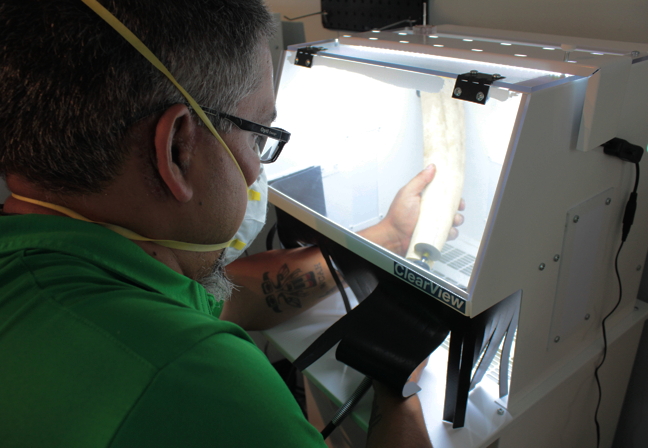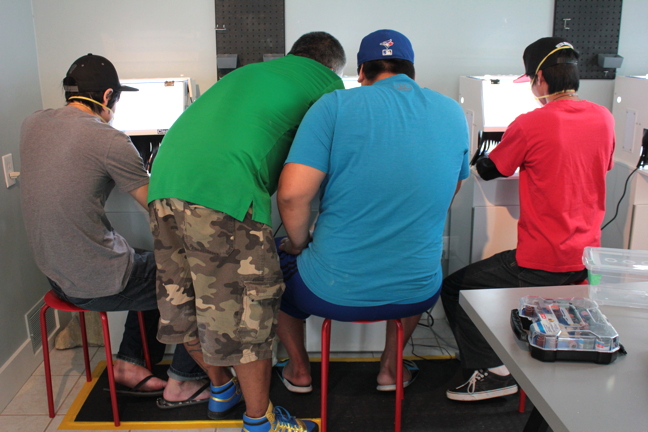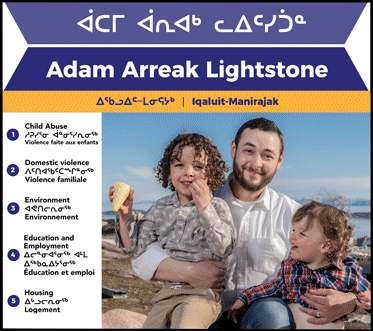Carving studio a gathering place for Ottawa Inuit youth
“For these guys, it gives them a skill”

Foster dad Joe Juralak looks up from his own project to see the hunk of serpentine Neil Evaglok has ambitiously chosen to work on.

Dion Metcalfe, seated at dust station, uses a rotary tool to cut walrus tusk into slices so carvers can make rings.

Facilitator Dion Metcalfe shows Neil Evaglok how to file down stone manually. (PHOTOS BY LISA GREGOIRE)
OTTAWA — Joe Juralak unties inline skates and enters the small, crowded carving studio at the back of a building in Vanier in sock feet.
It’s hot out this July afternoon and he’s sweaty from the journey. He cracks open a water bottle and downs it.
Two boys he’s fostering, Neil Evaglok and Charlie Manning, lock their bikes outside and enter the east Ottawa building, all smiles and wide eyes.
It’s busier than usual July 23 at this weekly carving drop-in and all the power tool stations are currently occupied.
No matter. Manning pulls up a seat and reaches into a plastic bin full of marble slab remnants. He’s going to make an inuksuk.
Evaglok fishes around in another bin full of raw serpentine stone. Unsatisfied, he opens a second bin with larger pieces the size of his head. Much better.
He grabs a big hunk of stone and struggles to put it on the table.
“What are you going to do with that?” asks facilitator Dion Metcalfe.
“Polar bear,” Evaglok says.
“Huh. Big one,” Metcalfe says, smiling.
Evaglok takes a file and starts hand grinding it. Metcalfe shows him the proper technique: one way, don’t saw back and forth. Evaglok does this for about five minutes before giving up. “So big!” he says in his defence.
Located at the Ottawa Inuit Children’s Centre’s youth facility on Queen Mary St., the carving shop occupies an air-conditioned back room which is decked out with all the tools and materials you might need to learn how to carve stone, antler, bone and tusk.
TD Bank gave the OICC money to purchase four electric dust collectors which allow carvers to use power tools indoors to grind stone and other materials without filling the room, and their lungs, with potentially harmful dust.
Electric Dremel rotary tools are attached to each dust collector console and carvers can use any number of bits to grind down their pieces including diamond bits for the hardest stone.
Metcalfe manages to find a lot of carving materials for free on his own time. He gets the serpentine stone from an abandoned quarry in Quebec and a local marble shop that makes gravestones and countertops donates leftover marble pieces.
For the other materials, such as antlers and walrus tusks, Metcalfe goes on Facebook group sites and posts his requests. He purchases mostly from hunters in Nunavut, he says.
Over the summer, the carving shop is open on Thursdays from 1 p.m. to 5 p.m. and anyone can drop by to refine their skills or explore a new hobby.
A youth worker from an Ottawa area group home has brought three boys of various ages. Two are Inuit and one is First Nations. They sit on stools at the power stations, face masks on, hunched over, focused.
One boy is making a small seal out of stone. The others are grinding walrus tusk disks into rings. They wear the uniform of youth: T-shirts, jeans, trendy ball hats.
“For these guys, it gives them a skill,” Metcalfe says. “If they come every week, they’ll learn.”
Metcalfe is only filling in as facilitator this summer. The centre plans to hire a full time arts coordinator, he says, to begin more extensive programming in the fall.
Ideally, the studio’s users will one day produce enough items for sale, Metcalfe says, with part of the proceeds going back to the centre to pay for those materials.
For now, it appears to be a place for Inuit youth to spend time together and try new things.
“Let the tool work for you. You don’t have to press hard,” Metcalfe says, when he hears the telltale whine of a tool in overdrive. He has to shout to be heard above four dust vacuums and four buzzing Dremels.
The boys cycle on and off the power stations, taking breaks when their hands go numb from vibration. One teenager comes over with a small nick on his finger.
Metcalfe asks him what happened.
“I wanted to know what it felt like,” he says, sheepishly, holding out his finger.
Metcalfe tells him to go wash the tiny wound while he fishes out a Band-aid from the First Aid kit. He shakes his head and smiles. “Can you believe that? He wanted to know what it felt like.”
For more information on this and other summer programs in Ottawa, contact the OICC at 613-744-3133.

Dion Metcalfe, in green, instructs young carvers on how to use power tools to grind down stone and tusk.





(0) Comments